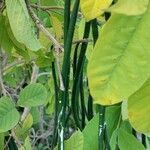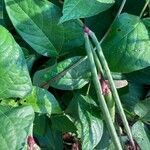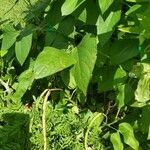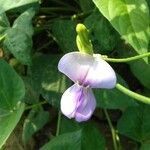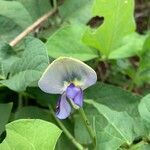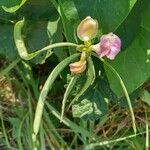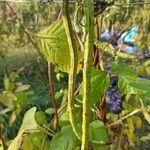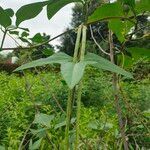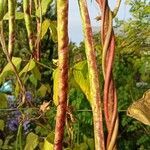Annual or perennial erect trailing or climbing herb, 1–3 m. long.. Stems striate, glabrous or slightly hairy particularly near the petiole-bases, sometimes with minute stiff hook-like hairs.. Leaflets 3, ovate, rhomboid or lanceolate, the laterals oblique, 1·5–16·5 cm. long, 1–12·5 cm. wide, all entire or terminal leaflets subhastate to 3-lobed at the base and laterals lobed on the outer margin, shortly acuminate or subacute and mucronulate, acute to rounded at the base, glabrous or sparsely pubescent on both surfaces; petioles 1·5–13 cm. long; rhachis 0·6–2·5 cm. long; petiolules 2–5 mm. long; stipules submedifixed, constricted at the point of attachment, upper part lanceolate, 0·6–2 cm. long, spur narrower, 2–6 mm. long.. Inflorescences axillary, few-several-flowered; rhachis 0·5–4(–5) cm. long; peduncle 2–36 cm. long, usually minutely uncinulate pubescent towards the apex; pedicels 1–2(–4) mm. long; bracts deciduous, lanceolate, 3–5 mm. long; bracteoles ± persistent, spathulate, 3–5 mm. long.. Calyx glabrous; tube 3–5·5 mm. long; lobes triangular-lanceolate, 2·5–14 mm. long, acuminate, ciliolate; upper pair joined for about half their length or only at the base.. Standard white, greenish, yellow or lilac-purple, paler outside, round, 1·2–3·3 cm. long, 1–3·2(–4) cm. wide, rounded or emarginate, glabrous; wings blue to purple; keel usually white or pale, not twisted.. Pods erect or eventually hanging in cultivated forms, linear-cylindrical, 5·5–10(–90 in some cultivated races) cm. long, 3–11 mm. wide, glabrous or minutely verruculose.. Seeds white to dark red or black, often mottled with black or brown, oblong or reniform, longest dimension 3·5–5(–12) mm., shorter dimension 2–3·5(–6·5) mm., 2·2(–4·5) mm. thick; hilum one-third to half the longest dimension, eccentric; rim-aril slightly developed.
Coarse erect or clambering herbs or vines; stems glabrous, drying terete or strongly angled. Leaves pinnate trifoliolate; leaflets ovate or lanceolate, the lat-eral leaflets strongly oblique, apically acute, acuminate or obtuse, basally obtuse, truncate or cordate, mostly 5-11 cm long, 1.5-5 cm wide, drying slightly discol-orous, glabrous except at the very base; petiolules ca. 3 mm long, pubescent; petiole and the rachis glabrous, drying angled, the petiole mostly exceeding the terminal leaflet; stipels elliptical, rounded, glabrous, the lateral pair 2 mm long, the terminal pair shorter; stipules large, ovate, acuminate, nervate, 7-16 mm long above insertion, produced into 2 oblong auricles to 5 mm long below insertion. Inflorescence 7-30 cm long, the few flowers congested at the apex; peduncle glabrous, erect; bracteoles 4-7 mm long, exceeding the calyx tube, glabrous, nervate, cucullate; bracts 2-3 mm long, glabrous, nervate, cucullate; pedicels stout, 1 mm long. Flowers various colors; calyx tubular campanulate, glabrous, 6-8 mm long, the upper pair fused, deltoid, the lower teeth acuminate, ca. 2 mm long; standard 1.5-2 cm long. Legume linear, straight or curved, slightly com-pressed, mostly 10-40 cm long, ca. 1 cm wide; seeds of various colors. This species is distinct in its glabrous stems leaves and foliage, in its large stipules which are produced below the insertion, and in its large bracteoles which are longer than the bracts or the calyx tube. The pods occasionally grow to great length, over 1 m long, but are mostly much shorter.
Annual or perennial erect trailing or climbing herb, 0.5-3 m long. Stem striate, glabrous, scabrous, pubescent or hairy. Leaflets 3, 1.5-16.5 x 1-12.5 cm, ovate, rhombic or lanceolate to linear, the laterals oblique, all entire or terminal leaflets subhastate to deeply 3-lobed at the base and laterals lobed on the outer margin, shortly acuminate or subacute and mucronulate, acute to rounded at the base, glabrous to pubescent on both surfaces; petiole 1.5-13 cm long; rhachis 0.6-2.5 cm long; stipules submedifixed, constricted at the point of attachment, multinerved, upper part lanceolate, 6-20 mm long, spur narrower, 2-6 mm long. Peduncle 2-36 cm long. Flower pink to purple, rarely white (mainly within var. unguiculata cultivar-group Melanophthalmus), 15-33 mm long; pedicel 1-3 mm long, not expanding as the pod matures; bracteoles 3-6 mm long, spathulate or lanceolate, 1-3-nerved. Calyx glabrous or pubescent; tube 2-5.5 mm long; lobes subequal, ciliolate, the upper pair joined for about half their length to form a broad lobe bifid at the apex or only at the base. Standard with 2 parallel widely spaced appendages. Pod 8-10 x 2.5-5 mm (except within cultivated races), linear-cylindrical, glabrous, scabrous, or pubescent. Seed 4-6.5 x 2-4.5 mm (except within cultivated races); hilum one third to half the longest dimension, excentric; rim aril slightly developed.
A creeping bean type plant with straight firm pods. Both cover crop types (leafy) and grain types occur. There is a deep tap root and many branches occur from it in the surface of the soil. The root nodules are large and round. They can be 5 mm across. The leaves have 3 leaflets. The end leaflet can be 12-16 cm long. This leaflet is larger than the side leaflets. The side leaflets are assymetrical. The stipules at the base of the leaf are large and with spurs at their base. Flowers occur often in pairs on the end of long flowering shoots. This stalk can be 2 cm to 30 cm long. Only 2-4 flowers in each stalk produce pods. Flowers are white, yellow or blue. They are large and showy. The standard petal is 2-3 cm across. The pods are about 15 cm long. The seeds are white except for a dark scar.
Annual or perennial herbs, erect, trailing, or twining. Stems 1-3 m, subglabrous. Stipules lanceolate, ca. 1 cm, with a narrow spur below point of attachment; leaflets ovate-rhomboid, 5-15 × 4-6 cm, lateral ones oblique, puberulent or glabrous on both surfaces, base acute to rounded, apex acute. Racemes axillary, with 2-6 flowers clustered at top of rachis. Calyx campanulate, 6-10 mm; teeth lanceolate. Standard yellowish white or violet, suborbicular, 1.2-3.3 × 1-3.2 cm, apex emarginate; wings blue to purple, subdeltoid; keel usually white or pale, not twisted. Legumes terete, 7.5-30(-90) × 0.6-1 cm. Seeds several, dark red or black, mottled with black or brown, oblong or reniform, 6-12 mm.
Annual or perennial, herbaceous climber, 0.2-2.0 m high/long; stems variable in thickness and indumentum. Leaflets variously shaped, obtusely trilobed, triangular-rhomboid to elongate-hastate. Stipules extended with spur beyond point of attachment, variably shaped, margins ciliate. Inflorescences axillary, elongated (4-7 flowers) or contracted racemes (2 flowers). Calyx campanulate, lobes ± as long as tube. Style prolongation horizontal or upturned by 45°, hammer-shaped. Petals: standard subrotund; keel straight, without pockets. Flowering time Sept.-Apr. Pod 200-300 mm in cultivated forms, non-dehiscent; 60-100 mm in wild forms, beaked, twisted spirally.
Leaflets 3, 1.5–16.5 × 1–12.5 cm, ovate, rhombic or lanceolate to linear, the laterals oblique, all entire or terminal leaflets subhastate to deeply 3-lobed at the base and laterals lobed on the outer margin, shortly acuminate or subacute and mucronulate, acute to rounded at the base, glabrous to pubescent on both surfaces; petiole 1.5–13 cm long; rhachis 0.6–2.5 cm long; stipules submedifixed, constricted at the point of attachment, multinerved, upper part lanceolate, 6–20 mm long, spur narrower, 2–6 mm long.
Flower pink to purple, rarely white (mainly within var. unguiculata cultivar-group Melanophthalmus), 15–33 mm long; pedicel 1–3 mm long, not expanding as the pod matures; bracteoles 3–6 mm long, spathulate or lanceolate, 1–3-nerved.
Calyx glabrous or pubescent; tube 2–5.5 mm long; lobes subequal, ciliolate, the upper pair joined for about half their length to form a broad lobe bifid at the apex or only at the base.
Seed 4–6.5 × 2–4.5 mm (except within cultivated races); hilum one third to half the longest dimension, excentric; rim aril slightly developed.
Pod 8–10 × 2.5–5 mm (except within cultivated races), linear-cylindrical, glabrous, scabrous, or pubescent.
Annual or perennial erect trailing or climbing herb, 0.5–3 m long.
Stem striate, glabrous, scabrous, pubescent or hairy.
Stems annual but often stout, subglabrous, twining
Standard with 2 parallel widely spaced appendages.
Flowers white and mauve-tinged or pink or yellow.
Peduncle 2–36 cm long.
